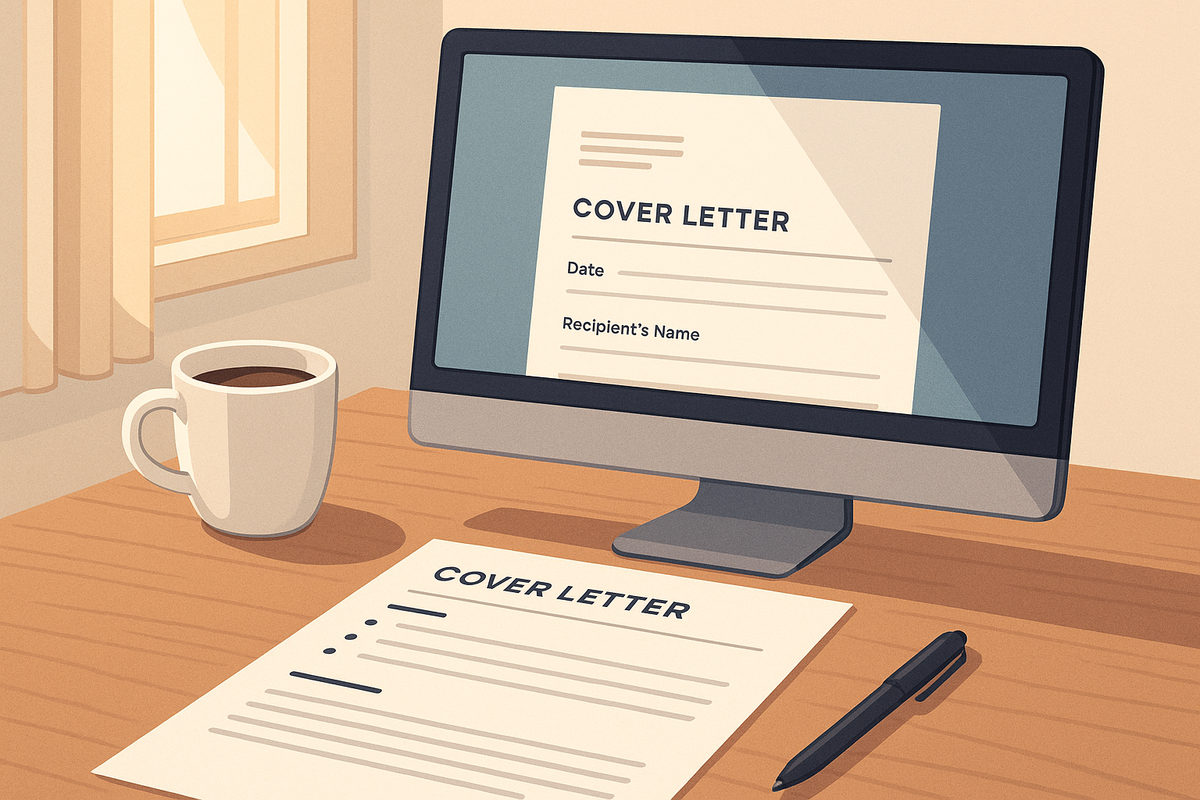Cover Letter Format: Key Elements to Include
Learn how to craft an effective cover letter that boosts your chances of landing an interview with key formatting and content tips.

In the U.S. job market, crafting a strong cover letter can boost your chances of landing an interview - especially when fewer than 2% of applicants make it that far. A good cover letter is clear, concise, and includes these essentials:
- Contact Information: Your name, email, phone, and LinkedIn profile.
- Date & Company Details: Hiring manager's name, title, and company address.
- Greeting: Address the hiring manager by name if possible.
- Opening Paragraph: Mention the role, where you found it, and a quick summary of your background.
- Body Paragraphs: Highlight achievements, skills, and experience relevant to the role.
- Closing Paragraph: Reaffirm interest, availability, and include a call to action.
- Professional Sign-off: Use "Sincerely" or "Best regards" and include your signature.
Formatting Tips:
- Use 1-inch margins, professional fonts (Arial, Calibri, Times New Roman), and keep it to one page.
- Align text to the left and maintain consistent spacing for a polished look.
Pro Tip: Tailor each cover letter to the job. Focus on specific skills or accomplishments that match the role, and proofread to avoid errors. A well-structured cover letter can help you stand out in a competitive market.
Main Parts of a Cover Letter
Contact Information
Make sure your contact header matches your resume's format for a consistent look. Include the following:
- Full Name (slightly larger font size works well here)
- Professional Email Address
- Phone Number (include the area code)
- City and State (full address is optional)
- Online Profiles, like a LinkedIn URL
- Portfolio or Website (if applicable, especially for creative roles)
Pro Tip: Use the same font and style as your resume to keep your application package visually unified. After your contact details, add the date and the company's information.
Date and Company Details
Write the date in the format Month DD, YYYY (e.g., April 25, 2025). Below the date, include:
- Hiring Manager's Full Name
- Their Job Title
- Company Name
- Company Address
Formatting Tip: Align all company details to the left for a clean, professional appearance.
Greeting
Address the hiring manager by name whenever possible. You can find their name by checking:
- The job posting
- The company's website
- Calling the company directly
If you can't find a name, use alternatives like:
- "Dear Hiring Manager"
- "Dear [Department] Manager"
- "Dear [Team] Team"
Avoid outdated greetings like "To Whom It May Concern" or "Dear Sir/Madam." After the greeting, jump into a strong opening paragraph to introduce yourself.
First Paragraph
Start with a compelling introduction by stating:
- The specific role you're applying for
- Where you found the job posting
- A brief summary of your background
For example:
"I am excited to apply for the Senior Marketing Manager position at [Company Name], as advertised on LinkedIn. With extensive experience in digital marketing and a history of driving measurable results, I am eager to bring my expertise to your team."
Middle Paragraphs
Use the body of your cover letter to spotlight your most relevant achievements. Focus on:
- The job's key requirements
- Your accomplishments, backed by measurable results
- Relevant skills, certifications, or technical expertise
Tip: Don’t just rehash your resume. Instead, expand on your most impressive achievements and explain how they align with the role. This is your chance to connect the dots between your experience and the company's needs.
Last Paragraph
End your letter by:
- Reaffirming your enthusiasm for the role
- Indicating your availability for an interview
- Thanking the reader for their time
- Including a clear call to action (e.g., "I look forward to discussing how my skills can contribute to your team.")
Sign-off
Close your letter with a professional sign-off, such as:
- "Sincerely,"
- "Best regards,"
- "Kind regards,"
For printed copies, leave space above your typed name for a signature.
Formatting Tip: Keep your cover letter to one page. Use standard 1-inch margins and a professional font like Arial, Calibri, or Times New Roman, sized 11-12pt. This ensures your letter is easy to read and visually appealing.
Cover Letter Writing Tips: How to Write a 10/10 Cover Letter ...
Layout Rules
Creating a consistent layout helps maintain a polished and professional appearance. Here's how to get started:
Page Setup
Start with these basic settings:
- Margins: Use 1-inch margins on all sides for a clean look.
- Font: Stick to professional options like Times New Roman or Arial.
- Font Size: Choose a size between 10 and 14 points for readability.
These simple adjustments create a solid base for your layout.
Spacing and Alignment
Keep the following in mind:
- Text Alignment: Align all text to the left for a uniform appearance.
- Spacing: Maintain consistent spacing between paragraphs and sections to make your document easy to navigate.
Tips and Resources
A polished cover letter is just one piece of the puzzle. These tips can help you fine-tune your application to stand out.
Make It Job-Specific
Tailor your cover letter to align with the job requirements. For instance, if you're applying for a software engineering position that prioritizes teamwork, mention your experience with collaborative projects or working across departments.
Key ways to customize:
- Match the company's tone
- Address specific job requirements
- Reference recent company updates or news
- Explain why you're excited about the role
Check Your Work
Proofread your cover letter thoroughly - mistakes can cost you an interview. Use this checklist:
- Double-check company names and details
- Read backward to spot spelling errors
- Ensure proper spacing and alignment
- Ask for feedback from a trusted friend or mentor
Save Time on Applications
Once your cover letter is ready, simplify your job search with efficient strategies. Scale.jobs users report saving 40% of their job search time by automating repetitive tasks.
"Applying to each job is such a painful process - sometimes it takes more than 15 minutes for one application... The team was a huge help in applying to jobs and was always available to talk. They followed my priorities when submitting applications."
- Aubrey Smith, Software Engineer
The platform offers tools to make your search easier and more effective:
- Cover Letter Generator
- Resume ATS Checker
- Job Applications Tracker
- Salary Predictor
- Interview Questions Predictor
"It felt pointless, and right then, I found scale.jobs, which helped me focus on the right things."
- Teja Aditya Surabhi, Product Strategy & Growth
Conclusion
A well-crafted cover letter can make a huge difference in your job search. According to data, scale.jobs users reduce their search time from five months to just 1–3 months. This not only saves time but also gives you an edge in a competitive market.
By incorporating the elements discussed earlier, you can create applications that are clear and impactful. The numbers back it up: 47% of positions secured by scale.jobs users come from direct applications, while 44% are achieved through personal networking.
Here are a few tips to enhance your job search:
- Ensure your formatting meets professional standards
- Tailor each cover letter to the job
- Leverage tools like cover letter generators and trackers
- Use the time saved to focus on networking and interview preparation
The results? Impressive. Around 70% of scale.jobs users receive a refund within 30 days because they land a job so quickly. As Mihika Srivastava shared:
"Apply at scale has immensely helped me with my tedious job application process. Their team is proactive and smart. Once they understand your profile, they are good at applying..."
A strong cover letter is just the beginning. Streamlining your process lets you focus on activities that lead to offers and potentially increase your salary by as much as $30,000.
FAQs
What are the key elements to include in a well-structured cover letter?
To create a strong and professional cover letter, be sure to include the following key elements:
- Header: Include your name, contact information, and the date, followed by the employer's details.
- Salutation: Address the hiring manager by name whenever possible.
- Opening Paragraph: Start with a compelling introduction that explains your interest in the role and company.
- Body: Highlight your relevant skills, experiences, and achievements that align with the job description. Use specific examples to demonstrate your value.
- Closing Paragraph: End with a polite call to action, expressing enthusiasm for the opportunity and inviting further discussion.
- Signature: Use a professional closing phrase (e.g., "Sincerely") and include your name.
A well-structured cover letter not only showcases your qualifications but also leaves a positive impression. If you need assistance crafting tailored cover letters, Scale.jobs can help by creating custom cover letters and resumes while you focus on networking and interview preparation - all for just $4/hour.
What are the most common mistakes to avoid when formatting a cover letter?
When formatting a cover letter, avoid these common mistakes to ensure your application stands out:
- Skipping essential sections: Make sure your cover letter includes a header, salutation, introduction, body, and closing. Missing any of these can make your letter feel incomplete.
- Using a generic template: Personalize your cover letter for each job application. Avoid copying and pasting the same content for every role.
- Overloading with information: Keep your cover letter concise and focused. Highlight only the most relevant skills and experiences for the job.
By structuring your cover letter carefully and tailoring it to the job, you can make a strong impression on potential employers.
Why should I address the hiring manager by name in a cover letter, and how can I find their name if it’s not provided in the job posting?
Addressing the hiring manager by name in your cover letter adds a personal touch and shows that you've taken the time to tailor your application. It helps create a stronger connection and demonstrates genuine interest in the role, which can make a positive impression.
If the hiring manager’s name isn’t listed in the job posting, try these strategies:
- Check the company’s website: Look for an “About Us” or “Team” page.
- Search on LinkedIn: Use the company’s profile to identify the hiring manager or relevant team lead.
- Call or email the company: Politely ask the receptionist or HR department for the appropriate contact person.
Taking the extra step to find their name can set you apart from other candidates and highlight your professionalism.




